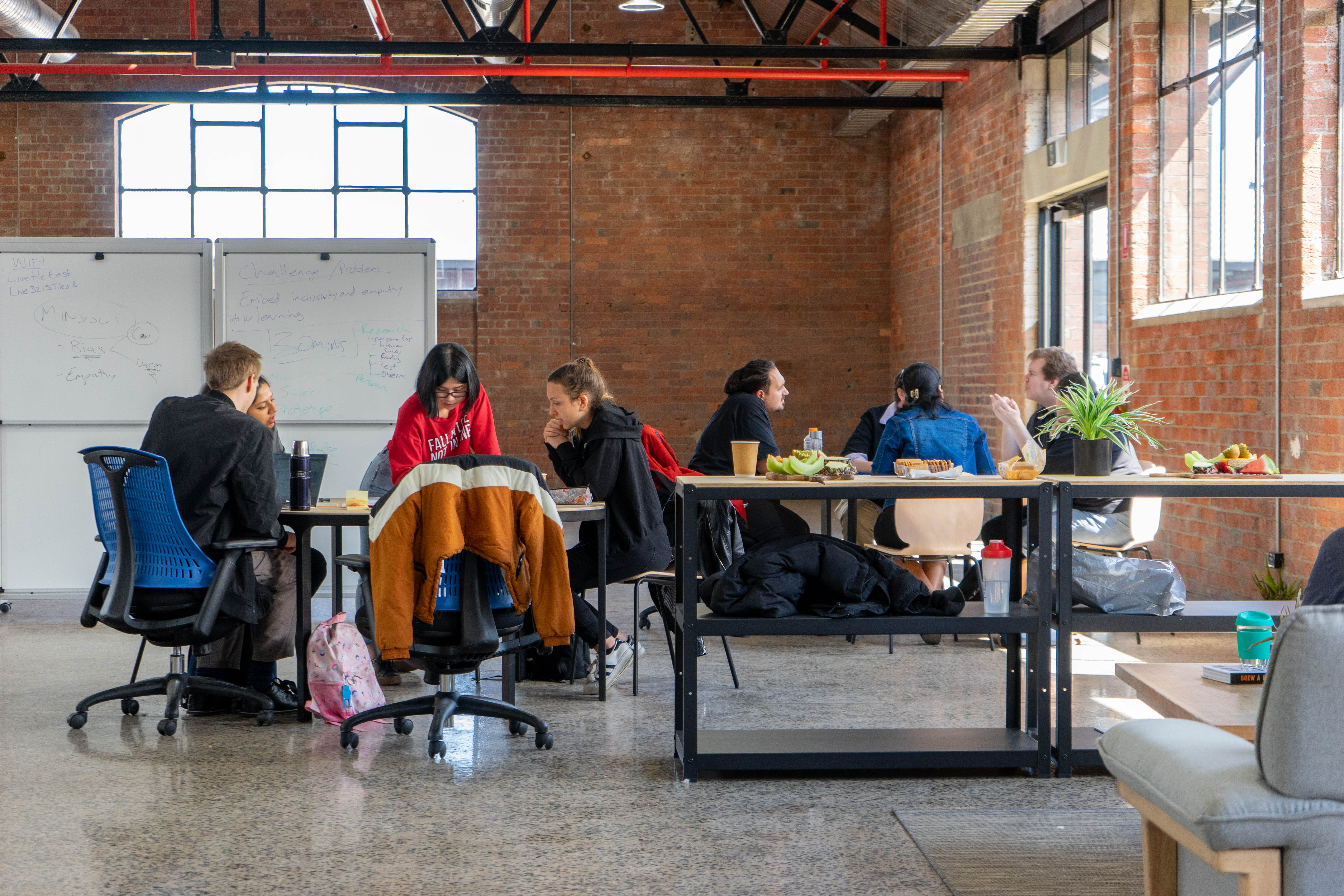Future of Work Lab drives tech innovation

Students and staff take part in a design sprint as part of the Future of Work Lab
In summary
- The Future of Work Lab is bringing together university and industry to solve complex problems and build skills
- Amazon Web Services (AWS), Cisco Systems and Two Bulls are working with the lab on a range of collaborative and co-created activities
- The lab’s activities include design sprints, industry consultations, workshops and seminars, applied research collaboration, and co-designed and delivered education programs.
Students, teachers, researchers and industry from a range of disciplines will come together as part of Swinburne’s new Future of Work Lab, a tech-enabled platform for innovation and complex problem-solving.
Major organisations such as Amazon Web Services (AWS) and Cisco Systems, and innovators like digital product company Two Bulls, are already partnering on a range of collaborative and co-created activities to prepare students to become leaders in modern workplaces and develop tech solutions to real problems.
The lab is the product of more than three years of work to build, pilot and optimise models of multi-disciplinary engagement with industry.
Chair of the Future of Work Lab Committee, Simona Jobbagy, says the lab is a hub for industry seeking to engage across the university. “It’s bringing everything together – research, teaching, learning, technology capability – into one place,” she says.
Partnering with industry
The lab is operating across a range of activities to boost disruption-led skills and attributes.
This includes design sprints, industry consultations, workshops and seminars, applied research collaboration, and co-designed and delivered education programs.
The lab has already partnered with not-for-profit organisations Our Watch and No to Violence to develop creative solutions for family violence prevention, and with ASX-listed software company LiveTiles on embedding cultural diversity into teaching and learning.

Laura Wilkinson, who facilitated these programs as the design sprints stream lead for the lab, says the feedback from students, teachers and industry has been overwhelmingly positive.
“Our industry partners have been impressed with how much we can produce in a short period,” says Wilkinson.
“For our students, they develop important teamwork, communication and critical thinking skills, make industry connections and get a massive confidence boost – it ticks so many boxes. They say it’s the most fun they’ve ever had in a group activity.”
Jason O’Donnell, Managing Director of Two Bulls, says Swinburne’s innovative approach to education aligns perfectly with his tech-focused work. “I love the idea of shifting the model of learning to be less about what course you chose when you were 17, towards engagement with industry and to be something that you are continually doing at the workplace or along your own pathway.”
“We want to support our team as they move between disciplines, make mini-pivots and micro-decisions in their career and that is really strongly supported by the work that Swinburne is doing, especially with the Future of Work Lab.”
Putting research into practice
The new lab reflects research from the Centre for the New Workforce (CNeW) which shows that collaboration on complex challenges across organisations and disciplines is much more effective for generating new ideas than working in silos.
“The lab aims to simulate the real world by bringing together a diverse group of students to work with our industry partners on understanding complex challenges they face,” says CNeW Director Dr Sean Gallagher.
“Our students will gain firsthand, valuable experience of this future of work now. And our industry partners will benefit from a diversity of experience, expertise and perspective in finding the new ideas required to solve their complex problems,” he says.
While programs have so far focused on vocational education students, Simona Jobbagy, says the emphasis on wide engagement has produced a number of university-wide partnerships and the lab will continue to expand into higher education and secondary schools.
“We are not just reflecting the future of work, but helping to shape it through research, engagement and action.”
-
Media Enquiries
Related articles
-

- University
Update on 131-133 Union Street, Windsor - December 2025
A December 2025 update from Swinburne University of Technology on the property at 131–133 Union Street, Windsor.
Monday 08 December 2025 -

- University
Swinburne launches Australian-first Undergraduate Certificate of Higher Education Studies
Swinburne has launched an Undergraduate Certificate of Higher Education, in an Australian-first that offers a new formal qualification to those who complete tertiary education but fall short of a degree.
Wednesday 10 December 2025 -

- Astronomy
- Technology
- Health
- Science
- University
- Sustainability
- Engineering
Swinburne highly cited researchers reach the top in 12 fields
Ten Swinburne academics have been named on the Highly Cited Researchers 2025 list, released by Clarivate
Tuesday 02 December 2025 -

- University
Over 550 students don caps and gowns to graduate from Children’s University Swinburne
Over 550 students from 34 schools have graduated from Children’s University Swinburne, celebrating over 45,000 hours of learning beyond the classroom this year.
Wednesday 03 December 2025 -

- University
Celebrating excellence at the Vice-Chancellor's Awards
Swinburne’s Vice-Chancellor’s Awards celebrate the ideas and initiatives that demonstrate our values and strategic vision in action.
Friday 12 December 2025

